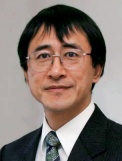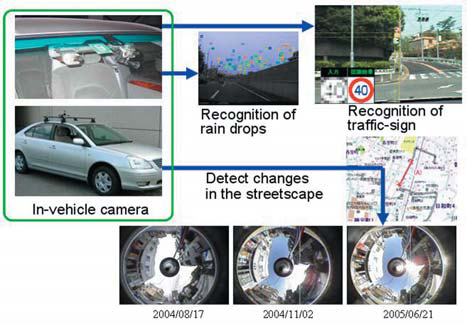Comprehensive List of Researchers "Information Knowledge"
Department of Media Science
- Name
- MURASE, Hiroshi
- Group
- Speech and Image Science Group
- Title
- Professor
- Degree
- Dr. of Engineering
- Research Field
- Image recognition / Intelligent vehicle / Recognition of broadcast data

Current Research
Video and Image Recognition for Supporting Human Vision
OUTLINEWe are studying video and image recognition to support human vision and to expand its range of capabilities. Especially, we focus on three research topics : recognition of low-quality images captured by portable digital cameras or mobile cameras, recognition of video data captured by in-vehicle cameras for driver assistance, and recognition and retrieval of large-size video streams such as broadcast data.
TOPICS
(1) Recognition of images captured by mobile cameras
Nowadays camera-equipped mobile phones or digital cameras are in widespread use. Technology for character recognition or image recognition using these cameras might be a convenient tool because it can be used for inputting information for dictionary retrieval, language transformation, or personal memoranda. The quality of these images is, however, quite low due to the low resolution or optical distortion of such cameras. We have developed new recognition methods to overcome these problems. First, we introduced a new method that integrates information from multiple frames based on robust statistics, which greatly improved recognition accuracy. Second, to reduce the cost of capturing a large number of training images, we have proposed a new method for generating training images in various conditions without actually capturing them. We call this method "generative learning."
(2) Video recognition for driver assistance
Driver assistance systems that recognize driving environments with an in-vehicle camera are attracting much attention. Traffic-sign recognition is a typical example of this technology. Images of a traffic sign captured from an in-vehicle camera are mostly low in quality, so to recognize such images accurately, we also use generative learning. To generate training images similar to real captured ones, we define six generation models to reflect the intensities of image degradation during capture. Experimental results have shown that recognition rates greatly improve compared to those of existing methods. Furthermore, we have developed another technology related to car navigation systems. Keeping a street map database up to date is very expensive, because investigators must walk around town to find changes. Our system constructs a database automatically by collecting video streams captured from many public vehicles equipped with an in-vehicle omni-directional camera and a commercial GPS. Our system can detect changes in the streetscape and update timely street maps for car navigation systems.
(3) Recognition and retrieval of broadcast data
DVD or hard-disc recorders enable us to store many hours of broadcast video streams. To handle such large-size stored video, various techniques for fast video retrieval are required. Our research focuses on"Retrieval of important news repeated many times during a day"and"Construction of a TV commercial database renewed from day to day."
We have developed a method for fast detection of duplicate sequences in the stored video footage. As experimental results show, our method reduces the detection time significantly while maintaining the same accuracy as existing methods.
FUTURE WORK
We will continue to develop novel methods for recognizing the following types of image data : (1) very low-quality images captured from mobile cameras or surveillance cameras, (2) data captured from in-vehicle cameras or in-vehicle radar sensors, and (3) large-size video streams such as broadcast data. These technologies show much promise for support human vision and lifestyles.

Figure : Recognition of images from in-vehicle cameras
Career
- Hiroshi Murase received his B. S., M. S., and Ph. D. degrees in electrical engineering from Nagoya University. In 1980 he joined the Nippon Telegraph and Telephone Corporation (NTT).
- From 1992 to 1993 he was a visiting research scientist at Columbia University, New York.
- Since 2003 he has been a professor in the Graduate School of Information Science, Nagoya University.
Academic Societies
- IEEE
- IEICE
- IPSJ
Publications
- A Quick Search Method for Audio and Video Signals Based on Histogram Pruning, IEEE Trans. on Multimedia, Vol. 5, No. 3, pp. 348-357 (2003).
- Focused Color Intersection with Efficient Searching for Object Extraction, Pattern Recognition, Vol. 30, No. 10, pp. 1787-1797 (1997).
- Visual Learning and Recognition of 3-D Objects from Appearance, International Journal of Computer Vision, Vol. 14, pp. 5-24 (1995).








